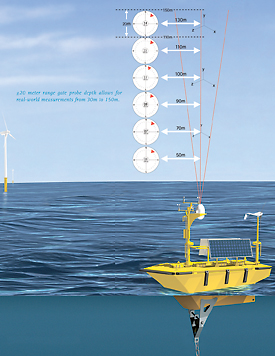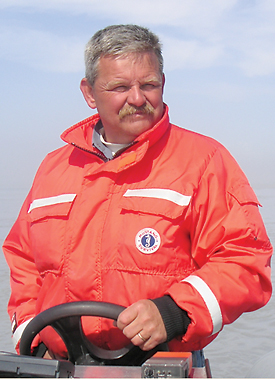In September U-M researchers will embark on a three-year feasibility analysis of offshore wind energy harvesting on the Great Lakes.
The $2.7 million study — a partnership led by the Michigan Memorial Phoenix Energy Institute (MMPEI) and Grand Valley State University’s Michigan Alternative and Renewable Energy Center (MAREC) — initially will launch roughly four miles off the coast of Muskegon where team members will anchor a large research buoy to measure the wind high above the Lake Michigan surface. The buoy will be relocated to other sites on the lake during the study.
“We’re using hard science and the latest technology to provide real answers about what’s possible from an engineering, environmental and economic standpoint,” says Guy Meadows, director of the Ocean Engineering Laboratory and a professor in the Department of Naval Architecture and Marine Engineering and Department of Atmospheric, Oceanic and Space Sciences.
Meadows and a team of U-M researchers from the College of Engineering and School of Natural Resources and Environment will study the nature of Lake Michigan’s offshore wind and weather, the structural effects of wind and icing on a turbine system, the potential environmental impact and issues related to site placement.

The six-ton WindSentinel buoy/research platform will measure the wind high above the Lake Michigan surface. Photo by Axis Technologies Inc. Click the image to see a larger photo.
Key to their research is the nearly six-ton WindSentinel buoy/research platform, purchased with grant funds by GVSU from AXYS Technologies in British Columbia, Canada. WindSentinel uses an advanced Vindicator® laser sensor developed by Virginia’s Catch the Wind Inc. that can measure wind speed and properties up to 150 meters above the water level, or roughly the height of a large, commercial wind-turbine tower.
“This is the first time this advanced technology will be deployed on the Great Lakes,” says Arn Boezaart, MAREC director.
WindSentinel will transmit its data to a shore station for preliminary evaluation by researchers from Grand Valley State’s Padnos College of Engineering and Computing. From there, the data will be forwarded to the U-M team for further analysis.
Meadows says the U-M team also will use underwater vehicles to explore the environment below the surface, including the lake floor. The submersibles, capable of extracting samples from the lakebed, are part of a set of environmental monitoring devices, including eight surface buoys that the Ocean Lab regularly deploys throughout the Great Lakes.
“The wind energy project ties in very nicely with our ongoing analysis of how wind and waves affect the Great Lakes coastline,” Meadows says, noting that the Ocean Lab works closely with the National Oceanic and Atmospheric Administration, sharing a research craft, R/V Laurentian, which is docked in Muskegon and likely will be used to tow WindSentinel into place this fall.

Photo courtesy Guy Meadows.
While wind power is clean and virtually limitless, questions remain over its practicality and desirability for commercial development. It’s estimated that 300 turbines are required to generate the same amount of electricity created by a mid-size coal fired plant. Offshore wind farms also pose challenges of energy storage and transfer to shore, as well as siting in potentially deep water.
“This study provides an unprecedented opportunity to answer many questions we all have about offshore wind energy and help responsibly guide its potential development in the region,” says MMPEI Director Dennis Assanis.
The MMPEI/MAREC collaboration also will include research on bird and bat flight patterns by scientist from the Michigan Natural Features Inventory of the Michigan State University Extension. The wind assessment research is supported by grants from the U.S. Department of Energy, the Michigan Public Service Commission, We Energies of Wisconsin and the Sierra Club.

